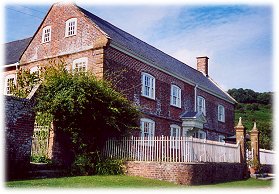Warblington Castle
An octagonal turret or tower from the gatehouse is all that remains of the Grade II listed Warblington Castle, which could have been described as a moated manor house. Situated on private land, the castle is not accessible, which reputedly does not stop its ghostly visitors. According to tradition Warblington Castle and nearby churchyard is thought to be haunted by the headless apparition of Margaret Pole, the Blessed, Countess of Salisbury and a smuggler, though I do not know any actual witness accounts.
![JuneGloom07 [CC BY-SA 4.0 (https://creativecommons.org/licenses/by-sa/4.0)], from Wikimedia Commons](http://www.mysteriousbritain.co.uk/wp/wp-content/uploads/2018/12/Warblington_castle-249x300.jpg) A History of the County of Hampshire: Volume 3 (1908) gives the following description ‘The ‘strong house of Warblington’ of Civil War days exists no longer, though whether by reason of damages then sustained does not appear. The only relic of its former importance is a tall octagonal turret of red brick and stone, once forming the angle of an entrance gateway, which must have been a fine building, dating from the early part of the sixteenth century. It was of four stories, and enough remains to show that it had square-headed mullioned windows, with arched heads to the lights. The present house, standing to the east of the gateway, is of no architectural interest.’
A History of the County of Hampshire: Volume 3 (1908) gives the following description ‘The ‘strong house of Warblington’ of Civil War days exists no longer, though whether by reason of damages then sustained does not appear. The only relic of its former importance is a tall octagonal turret of red brick and stone, once forming the angle of an entrance gateway, which must have been a fine building, dating from the early part of the sixteenth century. It was of four stories, and enough remains to show that it had square-headed mullioned windows, with arched heads to the lights. The present house, standing to the east of the gateway, is of no architectural interest.’
The moated Manor House was built by Margaret Pole, the Blessed, Countess of Salisbury, (Margaret of York) (Born 14 August 1473 – Died 27 May 1541), who was the daughter of George, Duke of Clarence (the brother of King Edward IV and King Richard III) and Lady Isabel Neville (Born 5 September 1451 – Died 22 December 1476), the daughter of the Kingmaker, Richard Neville, 16th Earl of Warwick (Born 22 November 1428 – Died 14 April 1471).
The manor which had been confiscated was restored to Margaret by King Henry VIII in 1514. According to A History of the County of Hampshire ‘She was living at the castle in 1526. She was a staunch papist, and from her house her son-in-law, Lord Montagu, and others sent frequent messages to their friends on the continent, especially to Cardinal Pole, using as an agent a certain Hugh Holland of Warblington, who had already been convicted of piracy. After her attainder in consequence of her share in these conspiracies Warblington was granted temporarily to William, Earl of Southampton, and to Sir Thomas Wriothesley, the king’s secretary.
As mentioned above Margaret Pole was attainted for treason and on 27 May 1541 she was beheaded at within the grounds of the Tower of London. She did not go to her death quietly and resisted her executioners who had to force down onto the block. The executioner who delivered the killing blow was later described as a ‘blundering youth’ as in total it took 10 clumsy blows attempting to kill her, hacking her head and shoulders to pieces. She is buried in the Chapel at the Tower of London.
Following Wriothesley and Southampton, the manor of Warblington was granted to Sir Richard Cotton, who’s family retained it until the English Civil War (1642–1651). The Cotton family supported the Royalist cause, and the house was demolished by Parliamentarian forces.
‘In January, 1643–4, ‘the strong house at Warblington’ was captured by sixty soldiers and a hundred muskets, and Richard Cotton was obliged to compound for his lands. He is said to have bequeathed them to his only surviving son William, who died in 1736. Under his will the manor passed to Thomas Panton, who sold his life interest to Richard Barwell of Stansted. The latter also bought the reversion from Baroness Willoughby de Eresby, and bequeathed the manor to trustees for sale. It was purchased in 1825 by Messrs. Brown & Fenwick, and in 1875 was held by the trustees of John Fenwick. In 1885 the manor was acquired by Messrs. H. G. Paine and Richard Brettell of Chertsey. [A History of the County of Hampshire: Volume 3 (1908)]




Recent Comments